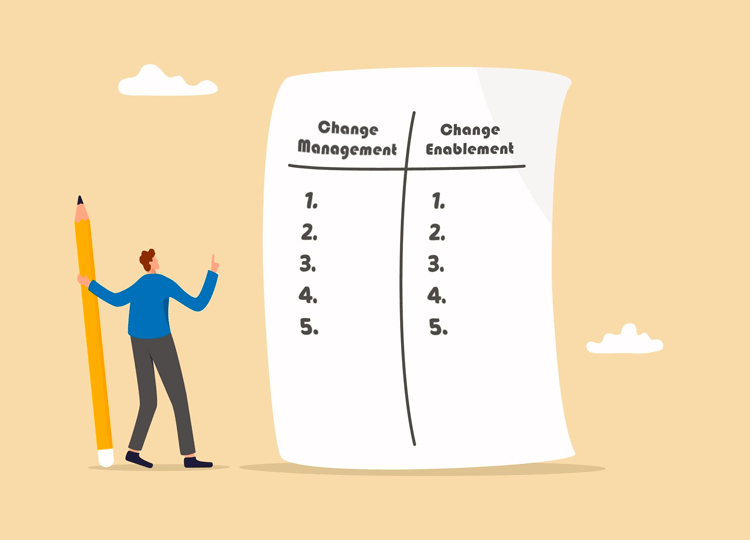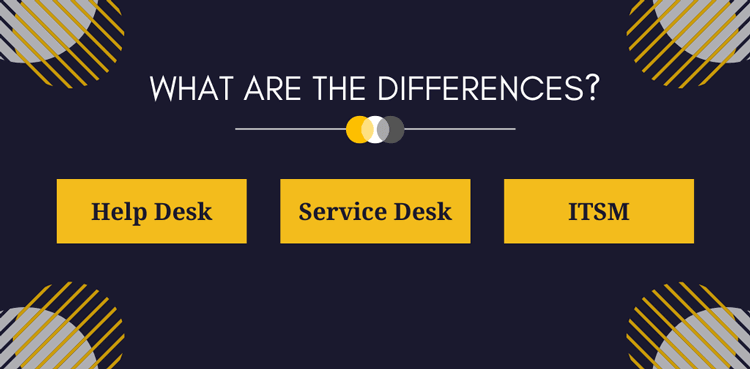Definition of Change Management vs. Change Enablement: How Do They Differ?
For any IT organization, the management of change is a challenging process to implement.
Over the years, the process of implementing change has become codified around a core best practice concept known as Change Management.
For IT leaders, CIOs, and IT professionals trained using ITIL® methodologies, the concept of Change Management has been replaced with a new, more dynamic framework known as Change Enablement.

In this article, we define and explain, and compare and contrast Change Management with Change Enablement. We then further outline how you can implement a successful Change Enablement program or project.
What is Change Management?
Change Management is a formal process within the "Service Transition" lifecycle of any IT Service Management (ITSM) operation or deployment of an IT service, such as software and hardware. Every technology service deployed within an IT organization team goes through numerous iterative service transitions and lifecycles.
According to ITIL Version 3, the Change Management definition "focuses on ... release practices, providing guidance and process activities for transitioning services into the business environment."
Change is inevitable and unavoidable in ITSM. However, how you manage any form of change procedures influences and impacts the outcomes of that process.
Within ITIL Change Management Version 3 framework, this is seen as a formal process to accomplish change. It usually involves Change Managers and Change Advisory Boards (CABs). Depending on the nature of the change, ITSM organizations might have to make a Request for Change (RFC) application. This might especially be required when a new budget is needed.
Under ITIL V3, any service transition appoints a "Change Manager" to handle everything strategic and operational. Change models guide Change Managers in these.
Change Managers are also often responsible for communicating operational and budgetary needs to senior leaders. Normally they need to make the business case for any proposed service or ITSM changes. This can include sourcing new vendors for projects. At the same time, Change Managers are responsible for getting buy-in, communicating project outcomes to staff, and coordinating training from different teams and across the organization.
Now let's examine Change Enablement so that the difference between the two concepts and models makes more sense.
Axelos is the company behind ITIL, PRINCE2, and other best practice training formats and models. In 2019, it launched a revised version of the ITIL best practice framework and training model, ITIL 4 (or ITIL v4).
Within ITIL 4, "an end-to-end operating model for the creation, delivery and continual improvement of technology-enabled products and services" is a key section on how to manage change.
Instead of this being known as "Change Management", Axelos changed the concept of how IT organizations should implement change-centric programs and strategies. This process is now known as Change Enablement.
What is Change Enablement?
Under ITIL 4, Change Enablement is outlined as a process whereby the "Sole responsibility is to maximize the number of successful IT changes by evaluating risks, authorizing changes to proceed, and managing the change schedule. They do this by matching the three types of changes with the three change authorities."
The dependencies to consider include the following: "All personnel ... follow the cardinal rule that nothing can change in the live environment without an approved Request for Change (RFC). [It] actively supports the IT department's goal to maximize the number of 'Standard' changes."
Within this context, ITIL 4 is more committed to recognizing the importance of DevOps practices and benefits. This is partly because ITIL 3 was published in 2007 and then revised in 2011. At those times, DevOps didn't play such an important role in ITSM and the IT service centers of high-growth and large organizations.
Publishing ITIL 4 corrected this oversight, reflecting the changing nature of IT operations, ITSM, and the inclusion of DevOps in business IT practices.
Further, ITIL 4 recommends taking into account the complexity level of any Change Enablement project when planning strategies.
Now let's take a closer look at the difference between Change Management and Change Enablement.
What's the Difference Between Change Management and Change Enablement?
Some of the most significant changes when Change Enablement took over from the more classic Change Management concept include the following:
- DevOps concepts such as fail-safe feedback and testing loops, iterative testing, and CI/CD now play a more important role in change enablement.
- Modern IT organizations and ITSM teams now recognize the value and benefit from faster iterative feedback loops. These reduce costs and lead to smaller change project implementations before cross-organization deployments. It's also much easier and quicker to identify when something is or isn't working. Instead of waiting months to see change effects, it allows faster deployment, testing, and iterations.
- Instead of encouraging companies to appoint a Change Advisory Board (CAB), ITIL 4 promotes designating change-focused people across various teams. Using this format, Change Enablement is easier to manage, quicker, and more cost and time effective.
- Organizations are also encouraged to use tools and technology to track workflows, backlogs, implementation, deployments, feedback loops, and collaborative processes.
Now we will take a closer look at how to implement a Change Enablement process model and deployment solutions in ITSM organizations.
5 Steps to Implement a Change Enablement Process Model in ITSM
Here are 5 steps you can take to implement a Change Enablement process, program, or project in your organization:
-
Get senior leadership sponsorship
Senior leadership sponsorship is almost always essential for the success of any ITSM Change Enablement project. New budgets are often required. Resources need to be redeployed. Training might be needed. For all of these, your ITSM team needs support from a C-Suite leader, such as the CIO, or someone on the same level.
-
Communicate well to relevant stakeholders
Change Enablement projects often involve different teams or departments affected by IT changes. It's important that you inform them long before they feel the impact of these changes on day-to-day workloads.
Plus, it's often the case that different teams and departments have useful inputs and insights you would benefit from. Maybe your organization's front-line staff have been struggling to use a particular piece of legacy software for years. During Change Enablement programs, it's a good time to overhaul or purchase new software that will improve efficiencies, and staff workloads, and save money.
-
Use gamification to support Change Enablement processes
Creating long-term changes often involves training and process modifications. Gamification is a very effective way to make these changes easier to manage and absorb for front-line and ITSM staff.
Gamification will solicit engagement, inspiration and interaction to help your team. Moreover, other departments retain new best practices and processes for months and years ahead.
-
Test on a small scale, iterate, and then scale up
One of the most significant differences between Change Management and Change Enablement is the use of smaller test projects before iterating and scaling up. Test anything new in a small-contained environment, such as a small team, before rolling out anything new on a larger scale.
-
Automate changes, keep testing, iterating, and monitoring
Whenever possible, automate any changes. Keep testing, iterating, and monitoring, implementing deployments in small batches. Also, ensure training and communication keep pace with any changes so that buy-in from the top and front line is continuous.
Automated workflow management software and dashboards make continuous implementation easier and more cost-effective.
For more information, see our ITIL Change Enablement page.
One way to support your Change Enablement process model in ITSM is to deploy Giva Change Management software. It's an ITIL-based, powerful technology solution, and one of the best ways to manage any change enablement process. Giva offers a 30-day free trial, so you can get hands-on experience: Demo Giva today!





